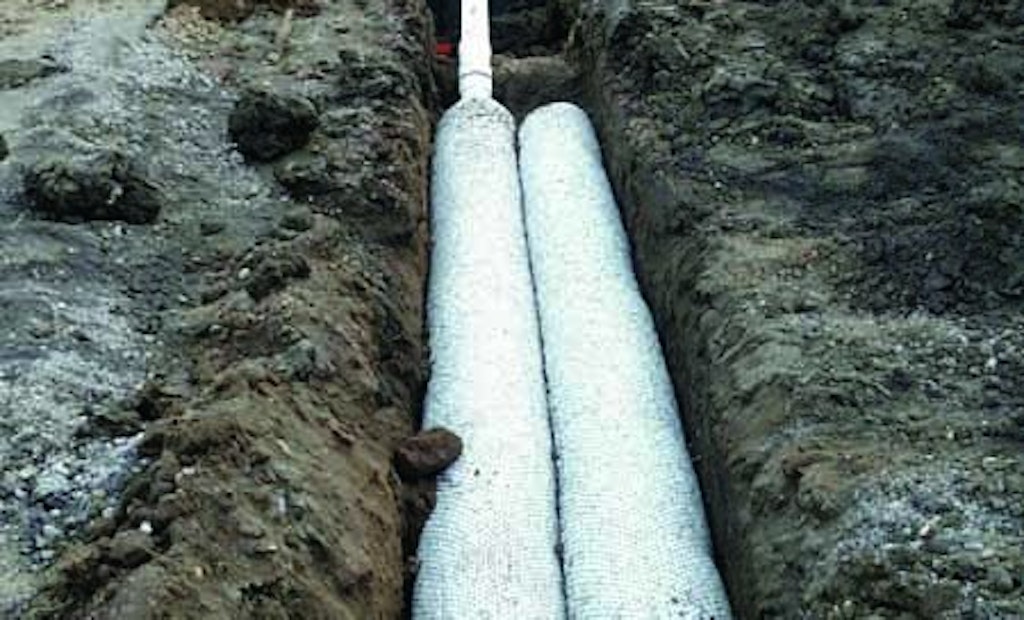Interested in Repair?
Get Repair articles, news and videos right in your inbox! Sign up now.
Repair + Get AlertsSupermarket tackles premature failure of leachfields
Problem: A supermarket chain with nearly 75 stores in Maine, New Hampshire and Massachusetts had ongoing issues with premature failure of conventional treatment systems. Experience indicated that a conventional system may fail as soon as two or three years after installation. A new store that opened in 2011 called for a design flow of 8,500 gpd of blended wastewater including kitchen, bakery and sanitary waste with anticipated biochemical oxygen demand of 650 mg/L.
Solution: Designers chose a Clean Solution aerobic treatment system from Advanced Onsite Solutions, which can be scaled to accommodate applications ranging from a single-family home to a large community or commercial system. In this moderate-sized system, effluent flows to a 12,600-gallon grease trap, then to an 8,500-gallon septic tank. From the septic tank, it flows through two 4,500-gallon aerated treatment tanks, then to two 5,000-gallon settling tanks, a 1,500-gallon pump station, and finally to a field of concrete chambers.
Result: As part of normal maintenance, in March 2015, grab samples were taken of both untreated effluent entering the system and treated effluent sent to the field. Biochemical oxygen demand coming in was 720 mg/L; going out was 8 mg/L, a 99 percent reduction. COD was reduced from 1,200 to 89 mg/L, a 93 percent reduction; FOG was reduced from 72 to less than 5 mg/L, a 93 percent reduction; and TSS was reduced from 170 to 8 mg/L, a 95 percent reduction. The system continues to run trouble free with regular inspections and pumping. 866/900-2415; www.aosne.com.
Treatment system meets discharge requirements
Problem: The Carenage Health Centre, located in Carenage, Trinidad and Tobago, replaced the previous location that was housed in an old Colonial building. The wastewater treatment system was commissioned in August 2015. The time frame from order to completion, including shipping and installation, was six weeks.
Solution: The treatment plant consists of a lift station that pumps the wastewater 12 vertical feet and across a 300-foot horizontal distance into a CromaFlow advanced wastewater treatment system. The model CF-30 treating 3,000 gpd includes advanced remote monitoring and operation by a technician utilizing a program logic controller. The CF-30 is buried with only the hatches exposed. It consists of four Salcor 3G UV disinfection units, in a series-parallel arrangement.
Result: The system was able to meet the strict discharge requirements and environmental standards of the Water and Sewerage Authority of Trinidad and Tobago. 570/435-5550; www.cromaflowinc.com.
MBR system saves business on sewer bill
Problem: Faced with a 1,320-foot distance to connect to the centralized wastewater treatment system, the owner of a commercial storage facility in central Bradley, Illinois, began exploring decentralized options. To gain decentralized system approval, the village required installation of a NSF 350 certified water-recycling system to accommodate the flow from restrooms and other facilities for office workers.
Solution: Ray Tebo of New Excavating Technology Inc. designed and installed a complete wastewater treatment system including a Bio-Microbics .5 (500 gpd) BioBarrier Membrane BioReactor installed within an Infiltrator Water Technologies IM-1060 tank. The modular MBR system uses advanced technology to produce recycled water. The tank offers strength in a lightweight and easy-to-transport design. The system had an Infiltrator IM-540 lift tank, followed by another IM-540 tank with a 1/16-inch SaniTEE for solids retention. The BioBarrier is followed by a 2- by 10-foot EZflow 1202GEO drainfield installed at the precise location where a double-ring infiltrometer test was conducted to test the hydrologic conductivity of the soil. The recycled water is then dispersed at .5 gpm for process control. An Aquaworx IPC duplex control panel controls the Champion pumps. The total footprint of the system is 8 by 40 feet.
Result: The system provides effective wastewater treatment, meets town regulations and so far has resulted in more than a $100,000 savings for the property owner when compared to connecting to the centralized sewer connection. 800/221-4436; www.infiltratorwater.com.
Drip system fit into small lake lot footprint
Problem: A residence on the shore of Grand Lake near Alpena, Michigan, appeared to be impossible to upgrade with its proximity to the water and tiny footprint. But it did have a small corner that met the needs for a subsurface drip system.
Solution: Perry Losinski, of Losinski Excavating & Septic, was able to draw on the SludgeHammer technology and expertise for the solution. The company had remediated dozens of small sites with its ABG by converting the outmoded septic systems to advanced treatment units. This provided the quality effluent needed for GeoFlow drip irrigation disposal and protection of lake water quality. An Infiltrator IM-1530 1,530-gallon tank slid in to replace the old tank, with room for a 1,000-gallon pump tank. SludgeHammer developed its own control box for the drip system.
Result: The drip system allowed treated effluent to be moved from the shoreline with discharge of highly treated effluent into the grass root zone for both nutrient uptake and extra distance from groundwater. 800/426-3349; www.sludgehammer.net.









